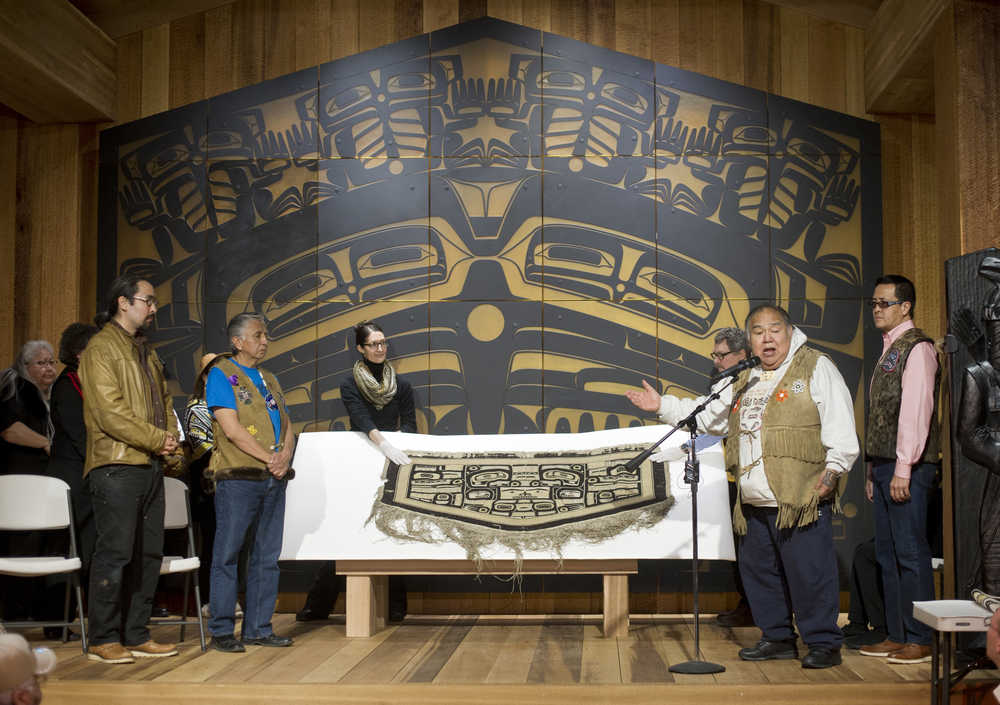More than 50 Southeast residents gathered at the clan house in the Walter Soboleff Building in Juneau Dec. 1 to celebrate the return of a Chilkat blanket sent by a collector in Texas.
Rosita Worl, president of Sealaska Heritage Institute, said the return was a moment of sorrow and joy — sorrow because it had been absent for so long and joy because it had returned.
The robe took an unlikely path to Juneau that included a stop on eBay, where SHI learned about it. Its seller was George Blucker, an artist from Illinois who now lives in a small Texas town northwest of San Antonio.
Blucker found the woven robe one day while visiting a flea market in southern Illinois. Blucker holds a master’s degree in art, and he thought he could identify the object draped across a dusty Volkswagen.
“I was like nah, no, that can’t be — but it was,” he said. “That’s a once-in-a-lifetime find.”
Blucker held on to the robe, keeping it preserved and protected in his home. “I was able to preserve it for — God, 25 or so years — and then it went back to where it’s supposed to be,” he said.
“I’m retired now, and on a more or less fixed income,” he said, which is why he decided to sell the robe.
It ended up on eBay, where tribal members saw the listing and notified SHI. In two days, SHI raised $14,500 — “In the fundraising mode we’ve been in, we’ve made some very good friends,” Worl said — and made an offer to Blucker, asking him to remove it from the auction site. He could have refused — there is no law mandating the return of Native artifacts in private collections, and previous Chilkat robes have sold for more than $30,000.
Instead, Blucker agreed.
“I could’ve used the money, but a lot of stuff is just more important than money,” he said.
EAGLE OR RAVEN?
Imagine a fat, downward-pointing triangle longer than it is tall. Now, chop off the left and right ends. What you’re left with is the shape of the robe, which is made of wool, possibly during the first half of the 19th century, explained Steve Brown, who consults with SHI from his home in Washington state.
Robes like these are usually divided into a central panel and two smaller, flanking ones. “A lot of them, into the middle of the 19th century, would conform to this particular arrangement,” Brown said. “This particular one has what appears to be a bird in the center.”
Chilkat designs can be abstract, which makes deciphering them difficult. Based on elements in the central panel — a pair of three-clawed feet and bird-like head shapes — “It very possibly could be interpreted as a thunderbird,” Brown said.
Because he’s not sure, and no one else is, the ceremony included representatives from both the Eagle and Raven moieties. That’s a somewhat unusual step for SHI, which has held previous return ceremonies.
“Since we are not sure what the crest is, it makes it more difficult for us,” Worl said. “These are the kind of things where you almost have to do innovative things.”
‘THEY WANT TO COME HOME’
With the robe protected in SHI’s collections, it will be accessible to weavers and other artists for examination and study. Traditional weaving was ordinarily passed down in a chain, master teaching apprentices who taught others. In the 19th century, through disease outbreaks and deliberate suppression of Native culture, few people kept up traditional weaving. Having an unknown artist’s work to study can be an inspiration and an insight into lost techniques, Brown said.
“Every time you see another robe or another design you haven’t seen before … you can get ideas of ‘Oh, I never thought about that before,’” he said.
In weaving, it might be as simple as where things connect. “Any time you have those kinds of new information, every different robe has the potential to provide some significant new information,” Brown said.
There’s also a connection on an emotional or spiritual level.
“Every object that’s repatriated … has the potential to inspire people visually, but also on an emotional level, as things people’s ancestors handled,” Brown said.
Worl and Blucker each said they’ve felt similar emotional and spiritual connections. “I know it’s hard to explain this at times,” Worl said, “I’ve just had cases where an object … sometimes they just seem like they want to come home.”

